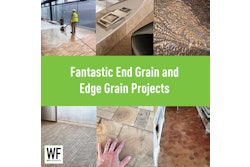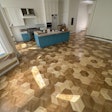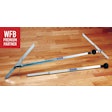Q: How do I determine which installation type is best for my specific job?
A: The truth is, each installation method for factory-finished wood floors—nailing/stapling, glue-down or floating—offers its own benefits. To determine which is best for your job, you must apply the benefits of each to the particular specifications of the installation site. Two key considerations are the type of subfloor being covered and whether the floor will be installed on, above or below grade. For most products, one or more installation methods will be appropriate.
Today's wide range of construction profiles and installation options allow hardwood to be installed in many areas of the home. The right installation method helps maximize the performance of the floor, enhance comfort underfoot and ensure that your customer enjoys the warmth and beauty of a hardwood floor for many trouble-free years to come.
Nail/Staple: the Industry Standard
Nailing or stapling is the most common method of installation simply because you can get excellent results using either one for both solid and engineered wood floors. Long strip floors must be stapled down, not nailed down. Correctly nailing or stapling the wood floor to the subfloor guarantees a firm, sound installation at a minimal cost. Fasteners cost only pennies per square foot, and the process is relatively quick and easy.
For the nail/staple method, installers can use either manual tools or tools that operate with compressed air. Many installers find that pneumatic tools greatly increase the number of square feet installed per hour.
There are two types of air-actuated tools. With the first type, the fastener is set into the floor by hitting the nailer/stapler with a mallet. This action accomplishes two things: It triggers the tool to engage the fastener, and it sets the plank firmly into position, tight against the subfloor and adjacent planks.
The second type, used by many installers for engineered floors, does not require the use of a mallet to position the board. Instead, a trigger shoots the fastener into place. This tool is an effective method; however, you must be sure that the board to be nailed/stapled is firmly set in place prior to setting the fastener. If the plank is not set tight against the subfloor and adjacent planks, air may collect. Although it is much easier to install the floor with a small amount of suspended air between the floor and subfloor, this can result in a squeaky floor. Taking extra care to set the plank into position prior to setting the fastener will avoid this problem and a possible callback.
Glue-down: a Popular Choice
The glue-down method is used in many areas of the home to install both engineered and long strip floors. With this method, the entire plank is attached to the subfloor, providing a permanent installation without the need for an additional subfloor. Glue-down installations greatly reduce the movement of a wood floor. This method is commonly used in slab construction, because it allows the wood to be attached directly to the concrete slab.
When gluing down a wood floor, always read and follow the manufacturer's instructions to be sure you are installing the floor correctly. Also, be sure to use the correct adhesive and trowel size for the product you have purchased. Many manufacturers offer adhesives that allow you to install the floor immediately after spreading the adhesive. However, if the adhesive requires rolling after the installation, be sure to do so. Correct adhesive transfer is vital for the long-term performance of the floor.
Floating: a Versatile Option
The floating method, recommended for longstrip floors only, allows you to quickly and easily install this type of floor over any dry, flat and structurally sound subfloor. More importantly, it allows hardwood installations over subfloors that are unsuitable for a solid or engineered floor, including vinyl,ceramic tile, terrazzo and other difficult-to-remove flooring. In addition, the use of a foam underlayment lends a softness underfoot and adds warmth to thesurface of the wood, particularly for installations over concrete.
When floating a wood floor, be sure to level any any high or low spots in the subfloor. A floating floor can be installed on, above or below grade. It also is recommended for radiant heat applications.
There are some basic tenets when it comes to construction types and installation methods. Solid floors must be nailed/stapled down and are recommended for on- and above-grade installations only. Engineered products may be nailed, stapled or glued, on,above or below grade. Longstrip floors may be stapled, glued or floated, on, above or below grade. In short, thanks to today's advanced manufacturing technology, no matter your installation situation, there's a hardwood floor that will meet your customer's needs.
































